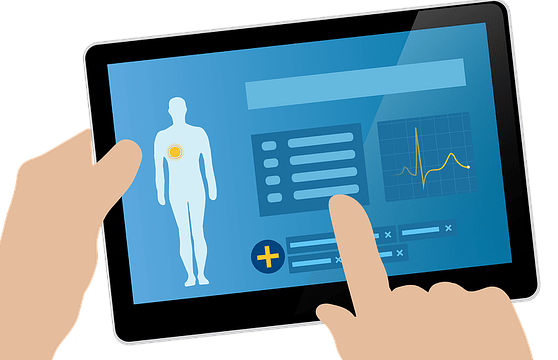Lab integration is a fairly common function for a functional electronic health record (EHR) software in this day and age.
Though intuitive and interoperable EHRs have become the gold standard, it’s not all that uncommon to find providers still doing labs on paper in concert with their software platform.
And, as an EHR company, it pains us to think of all the efficiency and accuracy these organizations miss out on without an electronic lab integration.
As a result, we thought we would examine just how much an EHR’s lab integration can transform this critical part of the treatment process.
Highly functional EHRs provide the following benefits to lab management:
- Improve the Review Process
- Painless Insurance Compliance & Reimbursement Process
- Ease of Use
- Patient Engagement
1) Review Process Made Easy
Most EHR lab integrations allow you to perform the lab results review process directly in the platform.
However, once lab results are generated in the platform, the degree to which different EHRs streamline the review process can vary greatly.
The EHR should send the lab results to the provider that ordered it for review. If the results are normal, then the platform should allow the provider to easily mark it as reviewed and move along to other tasks.
Effective EHRs set themselves apart by how they facilitate the necessary processes for abnormal results.
For example, comprehensive lab integration tools allow users to graph and trend values for recurring labs to monitor patient progress. Visualizations of complicated lab results help both providers and patients track their treatment.
In addition, an EHR should let users pass along results to make sure other parties view them if appropriate. This way, there is no time wasted for the user that is sending the results, and no necessary work for the receiver to acquire the results they must review.
Ideally, the entire transmission is completed in just a few clicks, preserving an efficient workflow.
Highly functional lab integration features can also facilitate follow-up tasks and/or follow-up tests based on a patient’s results.
The most efficient EHRs allow providers to request follow-up tests in the platform immediately after reviewing concerning or inconclusive results. This ensures that patients are treated promptly, especially in the case of urgent circumstances.

2) Insurance Compliance
Insurance companies have become much more stringent about labs in the last half-decade.
There is a lot of money to be made from discrepancies in lab coverage. Insurance companies have tightened up their standards considerably.
Their documentation demands have increased dramatically because labs are so expensive. Being able to demonstrate the review process is crucial to receiving necessary reimbursement.
If there is no proof of the review process, a provider can face unfortunate insurance repercussions. An EHR must have the ability to show that the correct individual examined results and did something with them
As a result, the following lab integration functions are now more important than ever:
- Capturing the diagnosis for the lab at the time of order entry
- Capturing the medical necessities for the lab test
Effective EHRs make these tasks easy for users by presenting them in a visible and accessible manner.
Capturing the medical necessity is perhaps the most important aspect here. It provides proof for a sufficient review process. This entails a doctor writing a summary explaining why the test was necessary to perform.
For maximum efficiency and compliance, doctors should not have to work to find or submit these critical explanations. A complete lab integration interface designates a clear space for doctors to capture this information up front when they are ordering labs.
Over the years, we have heard of some worst-case scenarios where laboratories have rescinded a provider’s ability to submit labs due to a failure to document medical necessity or demonstrate a review process.
We have also experienced firsthand how a properly documented review process can make all the difference when organizations are audited.
In some instances, our software provided our customers with the documentation that proved why a facility was ordering labs and how they were being used in treatment. As a result, our customers passed their insurance audit.
The EHRs that are most prepared to document the review process are those that are detailed and systematic. A platform that can demonstrate rock-solid documentation of the review process can make insurance reimbursement easy and insurance audits painless.
3) Ease of Use
A real-life clinical environment can be extremely hectic.
Ordering lab tests is only a small part of a doctor’s daily responsibilities. In the interest of the doctor’s time and a facility’s overall efficiency, an EHR’s lab integration tools should be intuitive and easy to use.
Effective EHRs can accommodate this need for speed and usability.
In the case of labs, one of the most important elements that promote efficiency is an ability to order tests in bulk.
Entering lab orders one at a time is simply impractical for many doctors. Quality lab integration tools provide the ability to batch labs, order lab panels, or both.
Batching up labs describes the process of ordering a batch of tests for one patient. This allows a provider to individualize a patient’s treatment in a timely fashion.
Lab panels describe pre-established sets of common labs used to determine the general health status of a patient.
With just a few clicks, a doctor should be able to order a set of routine tests to get a foundational picture of a patient’s health or submit precisely targeted labs to gather specific data on a patient’s condition.
Combined, these two features allow for a comprehensive, streamlined lab ordering process.
.jpg)
4) Patient Engagement
One of the most transformative aspects of EHR lab integration is the access that patients have to their personal health information via patient engagement software.
EHRs with highly functional patient portals can give patients ownership of their medical data.
When it comes to lab results, effective EHRs can present the patient with the same report that a doctor sees.
Instead of receiving a note or voicemail that briefly states their results were normal, patients are able to access their actual labs. These are the kinds of little things that contribute to patient satisfaction in a big way.
Access to official lab results is a fantastic feature, as long as the patient is able to read and understand the report. Unfortunately, there is no standardization in the format that laboratories provide results to a facility.
Some may send back a PDF document, some send a link to an HTML page, others may send nothing but raw data – it can be quite varied.
The most effective EHRs can synthesize a patient’s results for them. No matter what format the laboratory provided, the patient should be able to read and understand the results.
Behavioral Health Software: Further Education
We hope you have a better idea of just how much an EHR’s lab integration can enhance the entire lab system at your organization. Now you can begin an informed search for a platform that can best fit your operation.
The driving force behind quality lab integration features is a commitment to efficient processes that free up providers to focus on the actual treatment of patients, thus improving both operational and treatment outcomes.
Another crucial treatment aspect that is closely related to order labs is the ability to prescribe medication via an EHR. Check out this blog post that explores 3 other critical medical software solutions for any behavioral health organization.
If you were impressed with any of the streamlining features we discussed, you may be interested in what AURA, Sigmund’s enterprise solution software, has to offer.
AURA was built for health care providers, by former healthcare professionals and expert software developers. Using their insights, along with the valuable feedback from our customers, we strive to continually raise the bar for efficient and intuitive EHR technology.
If you would like to learn more about AURA’s lab integration, feel free to reach out to one of our knowledgable professionals today!


